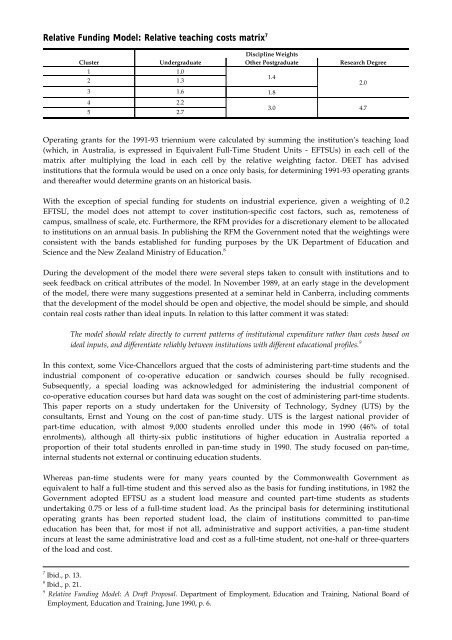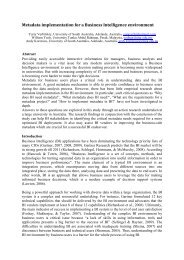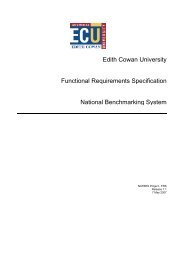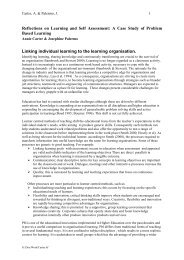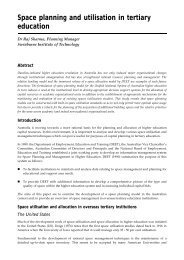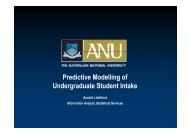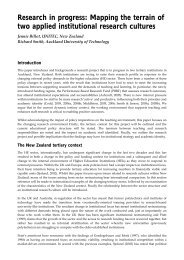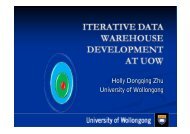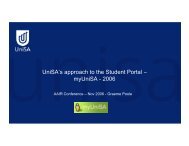Study of student costs using activity based costing methodology - aair
Study of student costs using activity based costing methodology - aair
Study of student costs using activity based costing methodology - aair
Create successful ePaper yourself
Turn your PDF publications into a flip-book with our unique Google optimized e-Paper software.
Relative Funding Model: Relative teaching <strong>costs</strong> matrix 7<br />
Cluster<br />
1<br />
1.0<br />
1.4<br />
2 1.3<br />
2.0<br />
3<br />
4<br />
5<br />
Undergraduate<br />
1.6<br />
2.2<br />
2.7<br />
Discipline Weights<br />
Other Postgraduate<br />
1.8<br />
3.0<br />
Research Degree<br />
4.7<br />
Operating grants for the 1991-93 triennium were calculated by summing the institution’s teaching load<br />
(which, in Australia, is expressed in Equivalent Full-Time Student Units - EFTSUs) in each cell <strong>of</strong> the<br />
matrix after multiplying the load in each cell by the relative weighting factor. DEET has advised<br />
institutions that the formula would be used on a once only basis, for determining 1991-93 operating grants<br />
and thereafter would determine grants on an historical basis.<br />
With the exception <strong>of</strong> special funding for <strong>student</strong>s on industrial experience, given a weighting <strong>of</strong> 0.2<br />
EFTSU, the model does not attempt to cover institution-specific cost factors, such as, remoteness <strong>of</strong><br />
campus, smallness <strong>of</strong> scale, etc. Furthermore, the RFM provides for a discretionary element to be allocated<br />
to institutions on an annual basis. In publishing the RFM the Government noted that the weightings were<br />
consistent with the bands established for funding purposes by the UK Department <strong>of</strong> Education and<br />
Science and the New Zealand Ministry <strong>of</strong> Education. 8<br />
During the development <strong>of</strong> the model there were several steps taken to consult with institutions and to<br />
seek feedback on critical attributes <strong>of</strong> the model. In November 1989, at an early stage in the development<br />
<strong>of</strong> the model, there were many suggestions presented at a seminar held in Canberra, including comments<br />
that the development <strong>of</strong> the model should be open and objective, the model should be simple, and should<br />
contain real <strong>costs</strong> rather than ideal inputs. In relation to this latter comment it was stated:<br />
The model should relate directly to current patterns <strong>of</strong> institutional expenditure rather than <strong>costs</strong> <strong>based</strong> on<br />
ideal inputs, and differentiate reliably between institutions with different educational pr<strong>of</strong>iles. 9<br />
In this context, some Vice-Chancellors argued that the <strong>costs</strong> <strong>of</strong> administering part-time <strong>student</strong>s and the<br />
industrial component <strong>of</strong> co-operative education or sandwich courses should be fully recognised.<br />
Subsequently, a special loading was acknowledged for administering the industrial component <strong>of</strong><br />
co-operative education courses but hard data was sought on the cost <strong>of</strong> administering part-time <strong>student</strong>s.<br />
This paper reports on a study undertaken for the University <strong>of</strong> Technology, Sydney (UTS) by the<br />
consultants, Ernst and Young on the cost <strong>of</strong> pan-time study. UTS is the largest national provider <strong>of</strong><br />
part-time education, with almost 9,000 <strong>student</strong>s enrolled under this mode in 1990 (46% <strong>of</strong> total<br />
enrolments), although all thirty-six public institutions <strong>of</strong> higher education in Australia reported a<br />
proportion <strong>of</strong> their total <strong>student</strong>s enrolled in pan-time study in 1990. The study focused on pan-time,<br />
internal <strong>student</strong>s not external or continuing education <strong>student</strong>s.<br />
Whereas pan-time <strong>student</strong>s were for many years counted by the Commonwealth Government as<br />
equivalent to half a full-time <strong>student</strong> and this served also as the basis for funding institutions, in 1982 the<br />
Government adopted EFTSU as a <strong>student</strong> load measure and counted part-time <strong>student</strong>s as <strong>student</strong>s<br />
undertaking 0.75 or less <strong>of</strong> a full-time <strong>student</strong> load. As the principal basis for determining institutional<br />
operating grants has been reported <strong>student</strong> load, the claim <strong>of</strong> institutions committed to pan-time<br />
education has been that, for most if not all, administrative and support activities, a pan-time <strong>student</strong><br />
incurs at least the same administrative load and cost as a full-time <strong>student</strong>, not one-half or three-quarters<br />
<strong>of</strong> the load and cost.<br />
7 Ibid., p. 13.<br />
8 Ibid., p. 21.<br />
9 Relative Funding Model: A Draft Proposal. Department <strong>of</strong> Employment, Education and Training, National Board <strong>of</strong><br />
Employment, Education and Training, June 1990, p. 6.


